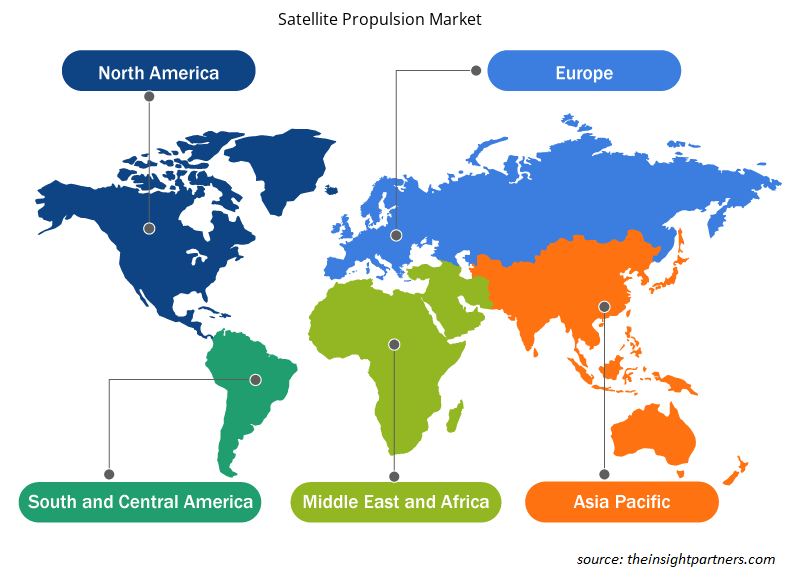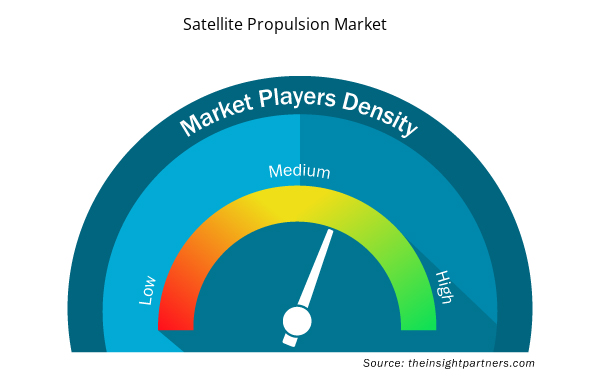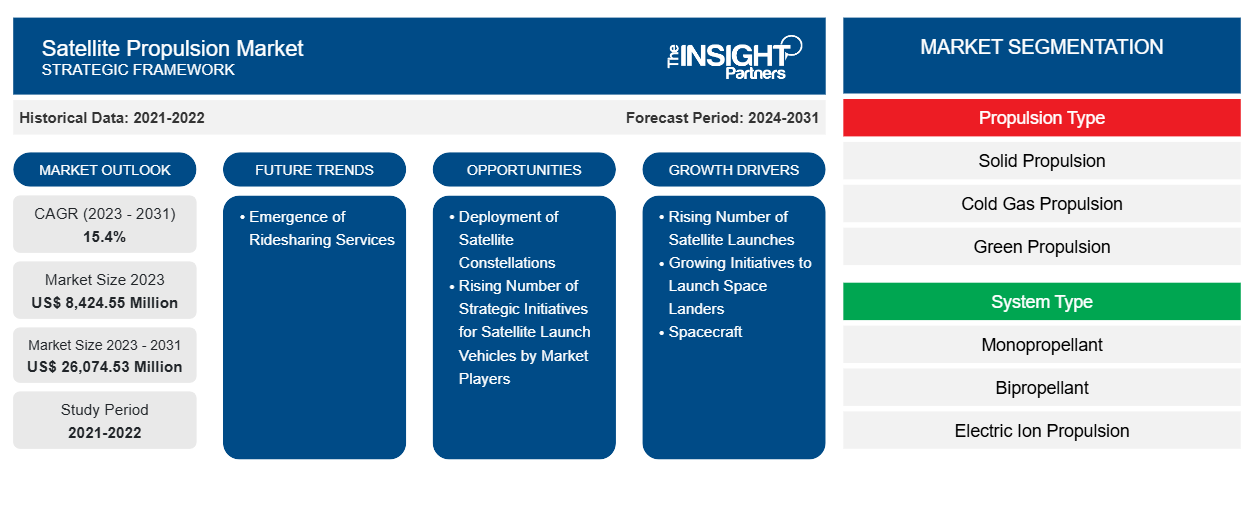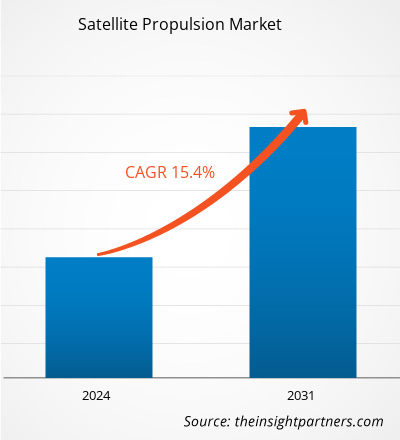卫星推进市场规模预计将从 2023 年的 84.2455 亿美元增至 2031 年的 260.7453 亿美元;预计 2023-2031 年期间的复合年增长率为 15.4%。
分析师观点:
卫星推进市场分为 北美、欧洲、亚太地区和世界其他地区(中东和非洲以及南美)。北美和欧洲是主要地区。诺斯罗普·格鲁曼公司、穆格公司和 AQST 加拿大公司等卫星推进系统供应商在北美的大量存在是该地区市场增长的主要推动力。
欧洲各国政府在太空技术方面的支出不断增加,卫星发射次数不断增加,推动了欧洲卫星推进市场的增长。欧洲市场受益于欧洲航天局 (ESA) 等组织推动的合作举措。这些伙伴关系促进了研发,鼓励了成员国之间的知识和专业知识交流,这也有助于卫星推进市场规模的扩大。
亚太卫星推进市场因产品创新和战略合作而不断增长。中国、印度、澳大利亚和日本等亚太国家高度重视卫星发射,已成为推动卫星推进技术发展的关键参与者。
市场概况:
由于卫星发射数量不断增加以及市场参与者的战略举措不断增多,航天领域不断发展,对全球卫星推进市场产生了积极影响。此外,对部署卫星星座的日益关注、对航天领域的投资不断增加以及拼车服务的日益普及,都推动了对卫星推进系统的需求。
卫星制造公司正专注于采购先进的卫星部件,以保持市场竞争力。2024 年 1 月,Bellatrix Aerospace 在印度空间研究组织的 PSLV C-58 运载火箭上发射了 Rudra 和 Arka 推进系统。2023 年,诺伊曼航天公司宣布其推进系统 Neumann Drive 通过 SpaceX Falcon 9 火箭(Transporter-8)从加利福尼亚州范登堡太空部队基地完成了首次太空任务。卫星发射数量的增加和公司不断增加的战略举措推动了全球卫星推进市场的增长。
定制此报告以满足您的需求
您可以免费定制任何报告,包括本报告的部分内容、国家级分析、Excel 数据包,以及为初创企业和大学提供优惠和折扣
- 获取此报告的关键市场趋势。这个免费样品将包括数据分析,从市场趋势到估计和预测。
市场驱动因素:
卫星发射数量的增加推动卫星推进市场的增长
用于通信、地球观测和导航等应用的卫星数量不断增加。根据联合国外层空间事务办公室 (UNOOSA) 的数据,2022 年全球发射了 2,474 颗卫星,而 2021 年全球发射了 1,810 颗。2024 年 1 月,伊朗利用由国防和武装部队后勤部制造的运载火箭发射了三颗卫星。2024 年 2 月,印度国家太空促进和授权中心宣布将加快太空活动,到 2025 年发射 30 颗卫星。2024 年 2 月,SpaceX 发射了一颗价值 9.48 亿美元的 NASA 卫星,主要用于了解气候变化。2024 年 3 月,SpaceX 在 Starlink 飞行中从范登堡太空部队基地发射了一枚猎鹰 9 号火箭。 2023 年,中国使用猎鹰 9 号火箭完成了 91 次发射,使用猎鹰重型火箭完成了 5 次发射,超过了 2022 年 61 次轨道发射的年度记录。2023 年,中国启动三颗低地球轨道宽带试验卫星的发射。英国太空司令部在 Minerva 项目和 ISTARI 计划下研制的作战概念演示卫星预计将于 2026 年发射。2023 年,法国的阿丽亚娜空间公司向太空发射了 12 颗卫星。2023 年,SpIRIT(空间工业响应智能热)纳米卫星发射升空,由墨尔本大学运营。该卫星是与意大利航天局和几家澳大利亚航天工业公司合作建造的。因此,卫星发射数量的增加推动了全球卫星推进市场的增长。
卫星发射计划的资金和投资增加反映了人们对太空探索、卫星部署和太空服务的日益重视。公共部门推动了对重型和超重型航天发射服务的需求,而私营部门则引领了对中小型卫星的需求。由于对发射低地球轨道星座或电信小型卫星的需求不断增长,中小型卫星是增长更快的行业。推动私人投资航天发射技术的其他原因包括轨道采矿、制造和旅游业。对航天发射需求的增加主要是由 SpaceX 的猎鹰 9 号中型火箭推动的。该火箭已经是 NASA 用于轨道任务的运载火箭,SpaceX 已被委托设计 NASA 的 Artemis 3 登月任务的航天器。此外,NASA 预计将与私营部门合作,支持商业创新并从私营部门采购商业太空服务。
发射计划投资的增加表明了对太空技术的更广泛的承诺。由于投资不断增加,推进系统制造商专注于开发先进的卫星系统。2023 年,HyPrSpace、Leonardo、Thales 和 CT Engineering 获得了一项价值 3800 万美元的项目的资助,该项目旨在展示一种可发射到太空的新型火箭发动机。因此,卫星行业投资的增加导致卫星发射数量激增,从而推动了全球卫星推进市场的增长。
节段分析:
根据推进类型,全球卫星推进市场分为固体推进、冷气体推进、绿色推进、电力推进和双极推进。电力推进越来越受欢迎。2024 年 3 月,印度空间研究组织 (ISRO) 宣布计划在其卫星上展示电力推进系统的使用。该系统由一个 300 毫牛顿 (mN) 的推进器组成。它预计将于 2024 年第二季度发射。电力推进系统的日益普及推动了卫星推进市场在电力推进领域的增长。
卫星推进市场区域洞察
Insight Partners 的分析师已详细解释了预测期内影响卫星推进市场的区域趋势和因素。本节还讨论了北美洲、欧洲、亚太地区、中东和非洲以及南美洲和中美洲的卫星推进市场细分和地理位置。

- 获取卫星推进市场的区域特定数据
卫星推进市场报告范围
| 报告属性 | 细节 |
|---|---|
| 2023 年的市场规模 | 84.2455 亿美元 |
| 2031 年市场规模 | 260.7453亿美元 |
| 全球复合年增长率(2023 - 2031) | 15.4% |
| 史料 | 2021-2022 |
| 预测期 | 2024-2031 |
| 涵盖的领域 | 按推进类型
|
| 覆盖地区和国家 | 北美
|
| 市场领导者和主要公司简介 |
|
市场参与者密度:了解其对商业动态的影响
卫星推进市场正在快速增长,这得益于终端用户需求的不断增长,而这些需求又源于消费者偏好的不断变化、技术进步以及对产品优势的认识不断提高等因素。随着需求的增加,企业正在扩大其产品范围,进行创新以满足消费者的需求,并利用新兴趋势,从而进一步推动市场增长。
市场参与者密度是指在特定市场或行业内运营的企业或公司的分布情况。它表明在给定市场空间中,相对于其规模或总市场价值,有多少竞争对手(市场参与者)存在。
在卫星推进市场运营的主要公司有:
- 穆格公司
- 阿丽亚娜集团
- 诺斯罗普·格鲁曼公司
- 泰雷兹公司
- 空中客车公司
- IHI 公司
免责声明:上面列出的公司没有按照任何特定顺序排列。

- 获取卫星推进市场顶级关键参与者概览
区域分析:
卫星推进市场报告的范围涵盖北美(美国、加拿大和墨西哥)、欧洲(西班牙、英国、德国、法国、意大利和欧洲其他地区)、亚太地区(韩国、中国、印度、日本、澳大利亚和亚太地区其他地区)、中东和非洲(南非、沙特阿拉伯、阿联酋和中东和非洲其他地区)以及南美洲和中美洲(巴西、阿根廷和南美洲和中美洲其他地区)。就收入而言,北美在 2023 年占据了卫星推进市场份额的主导地位。亚太地区是全球市场的第二大贡献者,其次是欧洲。美国、加拿大和墨西哥是北美的主要经济体。卫星发射和产品开发的增加推动了该地区的市场增长。由于卫星推进系统制造商的广泛存在以及政府对推动航天领域的日益关注,美国在卫星推进市场份额方面处于领先地位。诺斯罗普·格鲁曼公司、穆格公司和 AQST Canada Inc. 是北美提供卫星推进解决方案的参与者之一。此外,预计产品创新和合作与合并等重大发展将在预测期内推动北美卫星推进市场的增长。加拿大政府还致力于制定新的太空领域法规和支持政策。2023 年,加拿大政府宣布了一项多年计划,以支持该国私人建造的火箭发射计划。
美国航天工业在卫星发射和推进系统不断进步方面正在经历快速发展。2023 年,美国在卫星发射方面处于市场领先地位。2023 年,美国进行的 109 次卫星发射尝试中,有 98 次由 SpaceX 独立发射,2,234 颗美国制造的卫星中有 1,937 颗成功入轨。卫星发射数量的增加,以及卫星行业产品开发的不断增加,正在推动美国卫星推进市场规模的不断增长。2023 年,Terran Orbital 与 Safran 合作,探索在美国生产卫星推进系统。根据协议,Terran Orbital 和 Safran Electronics & Defense 预计将研究制造电力推进系统的机会和要求,该系统主要用于基于 Safran 的 PPSX00 等离子推力器的卫星。 2024 年 3 月,Benchmark Space System 的 Xantus 电力推进系统随 SpaceX Transporter-10 拼车任务发射升空。SpaceX 正在与美国情报机构合作制造一个由数百颗间谍卫星组成的网络。SpaceX 的 Starshield 业务部门正在根据 2021 年签订的 18 亿美元合同建立该网络。
关键球员分析:
Moog Inc.、ArianeGroup、Northrop Grumman Corporation、Thales SA、Airbus SE、IHI Corp.、Bellatrix、Aerospace Private Limited、Busek, Co. Ltd.、Safran SA 和 Avio SpA 是卫星推进市场报告中介绍的主要参与者。该报告根据当前卫星推进市场趋势和影响市场增长的因素,介绍了增长前景。
最新动态:
根据新闻稿,卫星推进市场参与者的一些最新进展如下:
年 | 消息 | 地区 |
2023 年 2 月 | 泰雷兹阿莱尼亚航天公司是泰雷兹 (67%) 和莱昂纳多 (33%) 的合资公司,该公司与韩国航空宇宙研究院 (KARI) 签署了一项合同,为其 GEO-KOMPSAT-3 (GK3) 卫星提供电力推进系统。GK3 计划于 2027 年发射,是一颗多波段通信卫星,将为朝鲜半岛及周边海域提供宽带卫星通信服务。特别是,它将支持国家海上救援和保护;监测山区、河流和水坝的水灾;并帮助应对其他灾害情况。 | 亚太地区 |
2023 年 11 月 | 巴黎综合理工学院、法国国家科研中心 CNRS 和赛峰电子与防务公司签署了合作协议,成立一个致力于电动卫星推进器研发的联合实验室。新单位名为 COMHET(霍尔效应推进器共同实验室),将专注于改进 HET 技术。 | 欧洲 |
- 历史分析(2 年)、基准年、预测(7 年)及复合年增长率
- PEST 和 SWOT 分析
- 市场规模价值/数量 - 全球、区域、国家
- 行业和竞争格局
- Excel 数据集



Report Coverage
Revenue forecast, Company Analysis, Industry landscape, Growth factors, and Trends

Segment Covered
This text is related
to segments covered.

Regional Scope
North America, Europe, Asia Pacific, Middle East & Africa, South & Central America

Country Scope
This text is related
to country scope.
常见问题
The rise in satellite launches, as well as product development, are a few of the major drivers for the satellite propulsion market in North America. The US is leading the satellite propulsion market owing to the wide presence of satellite propulsion system manufacturers and governments’ growing focus on advancing the space sector. Northrop Grumman Corporation, Moog Inc., and AQST Canada Inc., among others, are offering satellite propulsion solutions in North America.
Increased funding and investments in satellite launching programs reflect a growing emphasis on space exploration, satellite deployment, and space-based services. The public sector propels the demand for heavy- and super-heavy-lift space launch services, whereas the private sector leads the demand for small- and medium-lift satellites. The small- and medium-lift satellites are faster-growing sector owing to rising demand for launching low Earth orbit constellations or small satellites for telecommunications.
The substantial upsurge in satellite constellations has propelled the requirement for a competent satellite constellation management plan. To address this emerging need, companies and agencies operating in the space industry are analyzing the potential strategies for constellation launches, set-ups, alternatives for failed satellites, and end-of-life policies.
Moog Inc.; ArianeGroup; Northrop Grumman Corporation; Thales SA; Airbus SE; IHI Corp.; Bellatrix; Aerospace Private Limited; Busek, Co. Ltd.; Safran S.A.; and Avio S.p.A. are the key market players operating in the global satellite propulsion market.
Trends and growth analysis reports related to Aerospace and Defense : READ MORE..
The List of Companies - Satellite Propulsion Market
- Moog Inc.
- ArianeGroup
- Northrop Grumman Corporation
- Thales SA
- Airbus SE
- IHI Corp.
- Bellatrix
- Aerospace Private Limited
- Busek, Co. Ltd.
- Safran S.A.
- Avio S.p.A
The Insight Partners performs research in 4 major stages: Data Collection & Secondary Research, Primary Research, Data Analysis and Data Triangulation & Final Review.
- Data Collection and Secondary Research:
As a market research and consulting firm operating from a decade, we have published and advised several client across the globe. First step for any study will start with an assessment of currently available data and insights from existing reports. Further, historical and current market information is collected from Investor Presentations, Annual Reports, SEC Filings, etc., and other information related to company’s performance and market positioning are gathered from Paid Databases (Factiva, Hoovers, and Reuters) and various other publications available in public domain.
Several associations trade associates, technical forums, institutes, societies and organization are accessed to gain technical as well as market related insights through their publications such as research papers, blogs and press releases related to the studies are referred to get cues about the market. Further, white papers, journals, magazines, and other news articles published in last 3 years are scrutinized and analyzed to understand the current market trends.
- Primary Research:
The primarily interview analysis comprise of data obtained from industry participants interview and answers to survey questions gathered by in-house primary team.
For primary research, interviews are conducted with industry experts/CEOs/Marketing Managers/VPs/Subject Matter Experts from both demand and supply side to get a 360-degree view of the market. The primary team conducts several interviews based on the complexity of the markets to understand the various market trends and dynamics which makes research more credible and precise.
A typical research interview fulfils the following functions:
- Provides first-hand information on the market size, market trends, growth trends, competitive landscape, and outlook
- Validates and strengthens in-house secondary research findings
- Develops the analysis team’s expertise and market understanding
Primary research involves email interactions and telephone interviews for each market, category, segment, and sub-segment across geographies. The participants who typically take part in such a process include, but are not limited to:
- Industry participants: VPs, business development managers, market intelligence managers and national sales managers
- Outside experts: Valuation experts, research analysts and key opinion leaders specializing in the electronics and semiconductor industry.
Below is the breakup of our primary respondents by company, designation, and region:

Once we receive the confirmation from primary research sources or primary respondents, we finalize the base year market estimation and forecast the data as per the macroeconomic and microeconomic factors assessed during data collection.
- Data Analysis:
Once data is validated through both secondary as well as primary respondents, we finalize the market estimations by hypothesis formulation and factor analysis at regional and country level.
- Macro-Economic Factor Analysis:
We analyse macroeconomic indicators such the gross domestic product (GDP), increase in the demand for goods and services across industries, technological advancement, regional economic growth, governmental policies, the influence of COVID-19, PEST analysis, and other aspects. This analysis aids in setting benchmarks for various nations/regions and approximating market splits. Additionally, the general trend of the aforementioned components aid in determining the market's development possibilities.
- Country Level Data:
Various factors that are especially aligned to the country are taken into account to determine the market size for a certain area and country, including the presence of vendors, such as headquarters and offices, the country's GDP, demand patterns, and industry growth. To comprehend the market dynamics for the nation, a number of growth variables, inhibitors, application areas, and current market trends are researched. The aforementioned elements aid in determining the country's overall market's growth potential.
- Company Profile:
The “Table of Contents” is formulated by listing and analyzing more than 25 - 30 companies operating in the market ecosystem across geographies. However, we profile only 10 companies as a standard practice in our syndicate reports. These 10 companies comprise leading, emerging, and regional players. Nonetheless, our analysis is not restricted to the 10 listed companies, we also analyze other companies present in the market to develop a holistic view and understand the prevailing trends. The “Company Profiles” section in the report covers key facts, business description, products & services, financial information, SWOT analysis, and key developments. The financial information presented is extracted from the annual reports and official documents of the publicly listed companies. Upon collecting the information for the sections of respective companies, we verify them via various primary sources and then compile the data in respective company profiles. The company level information helps us in deriving the base number as well as in forecasting the market size.
- Developing Base Number:
Aggregation of sales statistics (2020-2022) and macro-economic factor, and other secondary and primary research insights are utilized to arrive at base number and related market shares for 2022. The data gaps are identified in this step and relevant market data is analyzed, collected from paid primary interviews or databases. On finalizing the base year market size, forecasts are developed on the basis of macro-economic, industry and market growth factors and company level analysis.
- Data Triangulation and Final Review:
The market findings and base year market size calculations are validated from supply as well as demand side. Demand side validations are based on macro-economic factor analysis and benchmarks for respective regions and countries. In case of supply side validations, revenues of major companies are estimated (in case not available) based on industry benchmark, approximate number of employees, product portfolio, and primary interviews revenues are gathered. Further revenue from target product/service segment is assessed to avoid overshooting of market statistics. In case of heavy deviations between supply and demand side values, all thes steps are repeated to achieve synchronization.
We follow an iterative model, wherein we share our research findings with Subject Matter Experts (SME’s) and Key Opinion Leaders (KOLs) until consensus view of the market is not formulated – this model negates any drastic deviation in the opinions of experts. Only validated and universally acceptable research findings are quoted in our reports.
We have important check points that we use to validate our research findings – which we call – data triangulation, where we validate the information, we generate from secondary sources with primary interviews and then we re-validate with our internal data bases and Subject matter experts. This comprehensive model enables us to deliver high quality, reliable data in shortest possible time.


 获取此报告的免费样本
获取此报告的免费样本